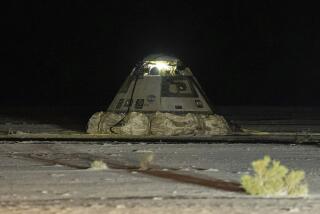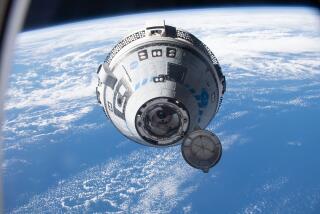NASA Plans Satellite-Saving Spacewalk
KENNEDY SPACE CENTER, Fla. — The space shuttle Columbia kept a respectful distance from a tumbling satellite Saturday as NASA devised a plan for two astronauts to go out and grab the out-of-control craft in a risky spacewalk.
“We sure have a lot of work ahead of us,” Mission Control informed the six-member crew. “Time to roll up our sleeves.”
It’s been more than five years since astronauts last hauled in a satellite with their gloved hands. It took three men to capture that satellite, which was three times the size of this one and never meant to be touched in space.
While this spacewalk would be easier, it’s dangerous nonetheless.
NASA managers said they would decide Sunday whether to have astronauts Winston Scott and Takao Doi attempt the daring rescue during an already scheduled spacewalk Monday night.
Scott and Doi trained before Columbia’s flight to seize the Spartan satellite, a 5-foot cube that weighs 1 1/2 tons on Earth. But no one expected it to be spinning, so the men practiced catching only a relatively still spacecraft.
After meeting Saturday, managers were leaning heavily in the direction of the rescue attempt, even though it would mean scrapping most of the space-station-building tests that had been planned for the six-hour excursion. Those tests already have been delayed a year; they were supposed to be conducted last November by two other astronauts, but a jammed hatch on Columbia forced a cancellation.
Another option being considered by NASA: using Columbia’s 50-foot robot arm to snare the satellite in the unlikely event it stops spinning so quickly.
Columbia’s crew accidentally sent the $10-million Spartan into a spin on Friday.
For reasons still unclear, the satellite failed to make a slow turn as expected after its release. When astronaut Kalpana Chawla tried to latch onto the satellite again with the robot arm, the craft began tumbling an estimated 2 degrees a second--too fast for her to snag. Columbia backed 25 to 50 miles away from the satellite.
Even though scientists immediately had to abandon their mission to use it to study the sun, they asked that Spartan be brought back to Earth so it can fly again.
*
Teams of engineers and astronauts began rehearsing the moves that would be needed to capture the craft, using shuttle simulators and virtual-reality computer labs as well as a giant pool at Johnson Space Center in Houston that provides an approximation of weightlessness.
Mission Control’s preferred method would be to have one man on each end of a platform that spans the width of the cargo bay. Once Columbia flies up to the satellite and the men grab it, the robot arm could lower it into its cradle. The other method would have Scott catching the satellite by himself while hovering above the cargo bay on the end of the robot arm.
Commander Kevin Kregel said either way was “definitely doable.”
More to Read
Sign up for Essential California
The most important California stories and recommendations in your inbox every morning.
You may occasionally receive promotional content from the Los Angeles Times.










